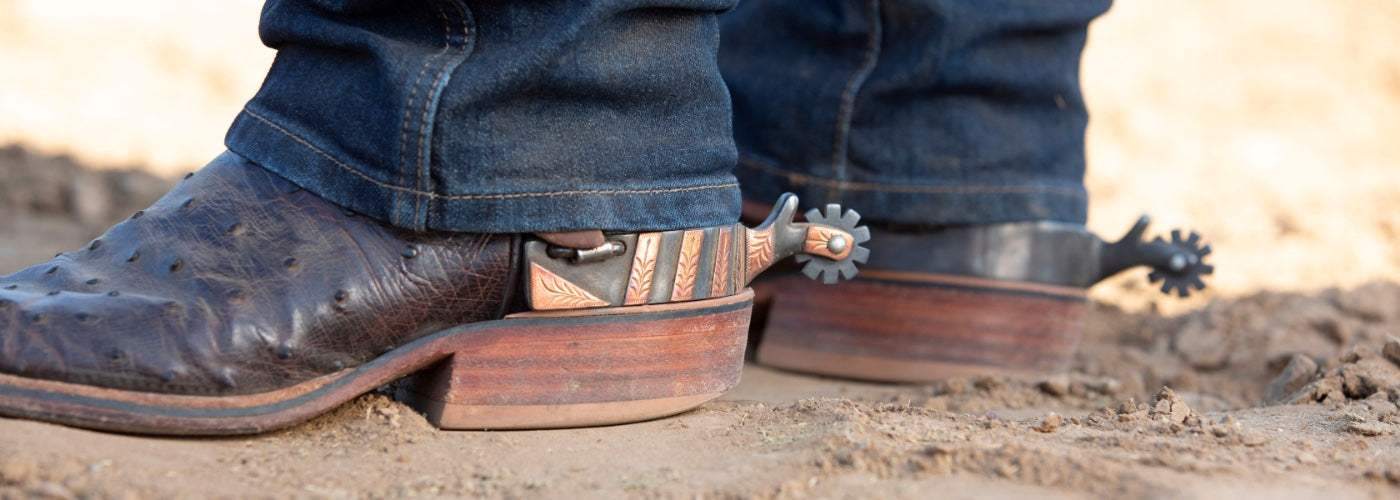
What Spurs Are Right For You?
If you've heard the jingle jangle when a cowboy walks by, you may think that spurs are just for show. However, different Western spurs actually serve specific functions, and we will talk about the functions of each to help you determine what spurs are right for you. There are many different types of spurs to choose from, and making the decision can be difficult. Spurs are vital pieces of cowboy equipment, so it's essential that you pick the right ones for your skill level and riding discipline. We're going over the basics of selecting the right types of Western spurs. This guide will touch on the various parts of a spur and things to consider when making your choice.

What Are Boot Spurs For?
Spurs are one of the ways that cowboys and cowgirls show off their personalities. Just like a custom cowboy hat or saddle, spurs are an extremely personal choice. But it's important to keep in mind that, besides adding a bit of flair to boots, all types of spurs are primarily used for communicating with horses. Spurs are used as a:
- Training device
- Supplemental way to emphasize a command
- Means for conveying more precise instructions between rider and mount
Spurs are an effective tool when used correctly. Leg cues should always be used first, with spurs used as a reinforcement for the cue that is being given.
Parts of a Spur
The various types of spurs can look very different, but all include the same components, and some of that spur hardware can wear out and be replaced.
- Button - holds the spur on the strap.
- Heelband - U-Shaped piece that fits around the back of the boot; also known as the yoke or branch.
- Swing Arm/Spur Hanger - connects the button to the heelband.
- Shank - a metal bar that holds the rowel to the heelband and holds it away from the boot.
- Rowel - the wheel-shaped business end of the spur that makes contact with the horse.
- Spur Pin - attaches the rowel to the shank

Spur straps help hold the spurs in place and can add an additional decorative element. You can use replacement spur parts to make easy repairs, though a high-quality pair will last for decades when well cared for.
What to Consider When Choosing Your Spurs
There are a few key considerations to think about when buying a new pair of spurs. The proper combination of experience, rowel and shank will create the best performance.
- Boots - should have a spur heel rest for the best fit.
- Shank Length - is usually determined by the experience of the rider and the discipline being exhibited. For instance, cutting and cowhorse horse trainers will often ride a longer shank and larger rodel than a competitive rodeo athlete. The most important thing to keep in mind when choosing the length of you spur shank is making sure you are able to keep your spurs from making contact with the horse when a cue is not needed.
- Spur Rowel Types - determine the assertiveness of the spur. Novice riders and tender-sided horses benefit from a rowel with more teeth that are closer together because they are much more gentle. Rowels with fewer teeth and more spacing are more severe and should be reserved for experienced riders.
- Experience Level - is critical when selecting spurs. It's important to know when to use them and the proper pressure. Proper leg control is necessary for spurs with more bite.
Always try on spurs while wearing the boots you'll be wearing to ride to make sure they fit correctly.
Some of the Most Common Types of Spurs
There are many different types of spurs available, and they vary based on the discipline of riding they are intended for. Western spurs are generally ornate and heavy with rowels that rotate. Because of the longer stirrups and heavier saddle fenders on a Western saddle, long shank spurs with wider rowels are preferred because the Western rider's leg position is farther away from the animal.
Cloverleaf
Cloverleaf-roweled spurs look like a flower and have blunt ends. They are some of the best spurs for beginners because they are among the mildest rowel configurations available.

Barrel Racing Spurs
Barrel racers generally wear bumper spurs. Instead of having a traditional shank and rowel, they have a bar that wraps around the back of the heel of the boot. The bar can be either smooth or ribbed. A rider may choose barrel riding spurs with a very soft rowel instead of a bar.

Roping Spurs
Roping spurs have short shanks and small rowels to avoid contact with the horse when the cowboy stands up to throw a loop. A roping spur is also commonly worn by steer wrestlers and other timed event rodeo competitors as well.

Western Pleasure Spurs
Unlike most other disciplines, many western pleasure riders use spurs to slow their horses down instead of speed them up. A ten-point rowel is the most common type used. Western pleasure spurs can control the horse without using the bridle if used properly.

Find All the Best Types of Spurs at NRS
Whether you're trail riding, roping, or showing your performance horse, NRS has all the different types of spurs you need for whatever type of riding you have planned. The proper spurs help you fine-tune cues used to communicate with your horse as well as show off your personal style. Shop our extensive collection of Western riding spurs today!
Shop Spurs

